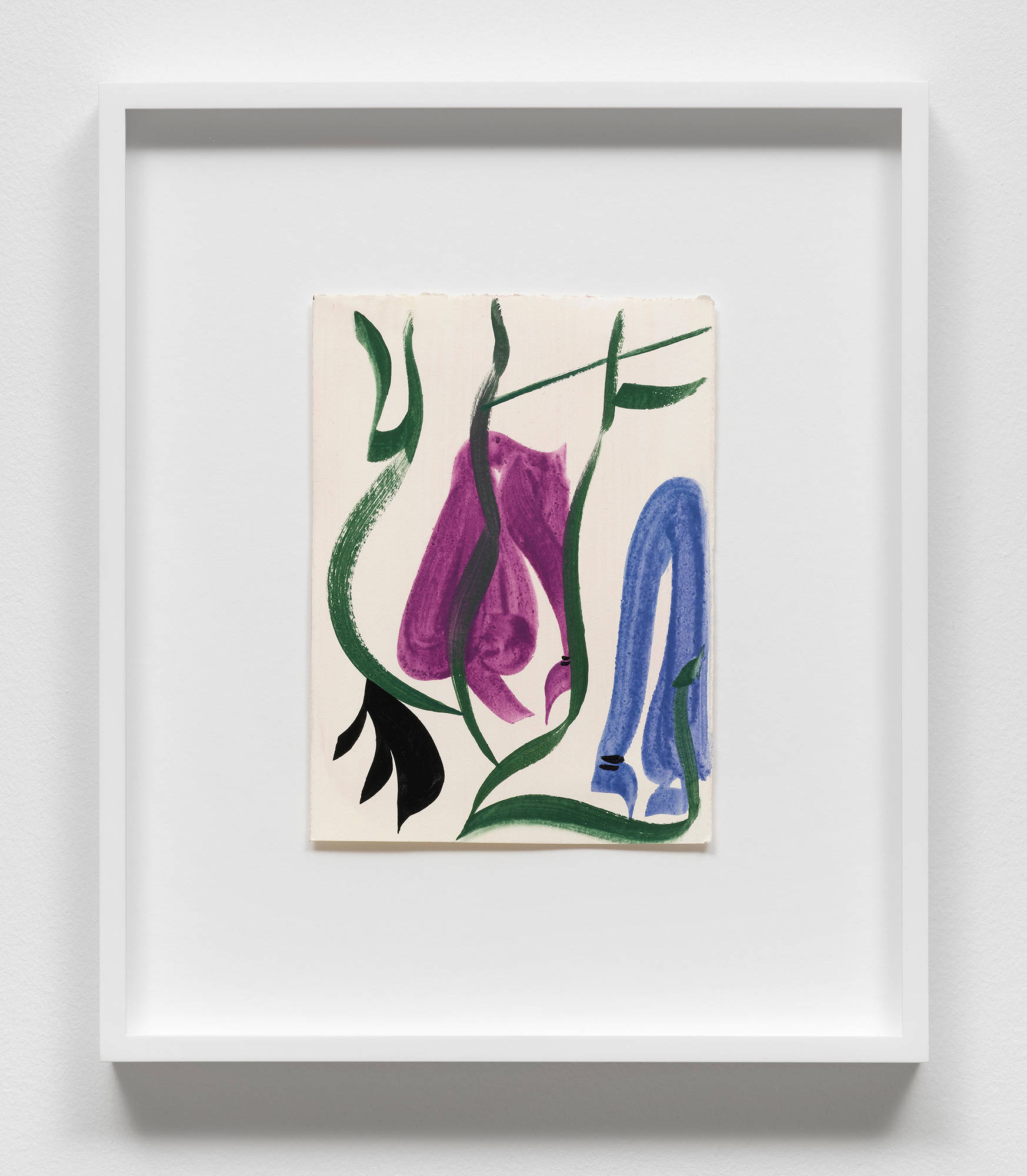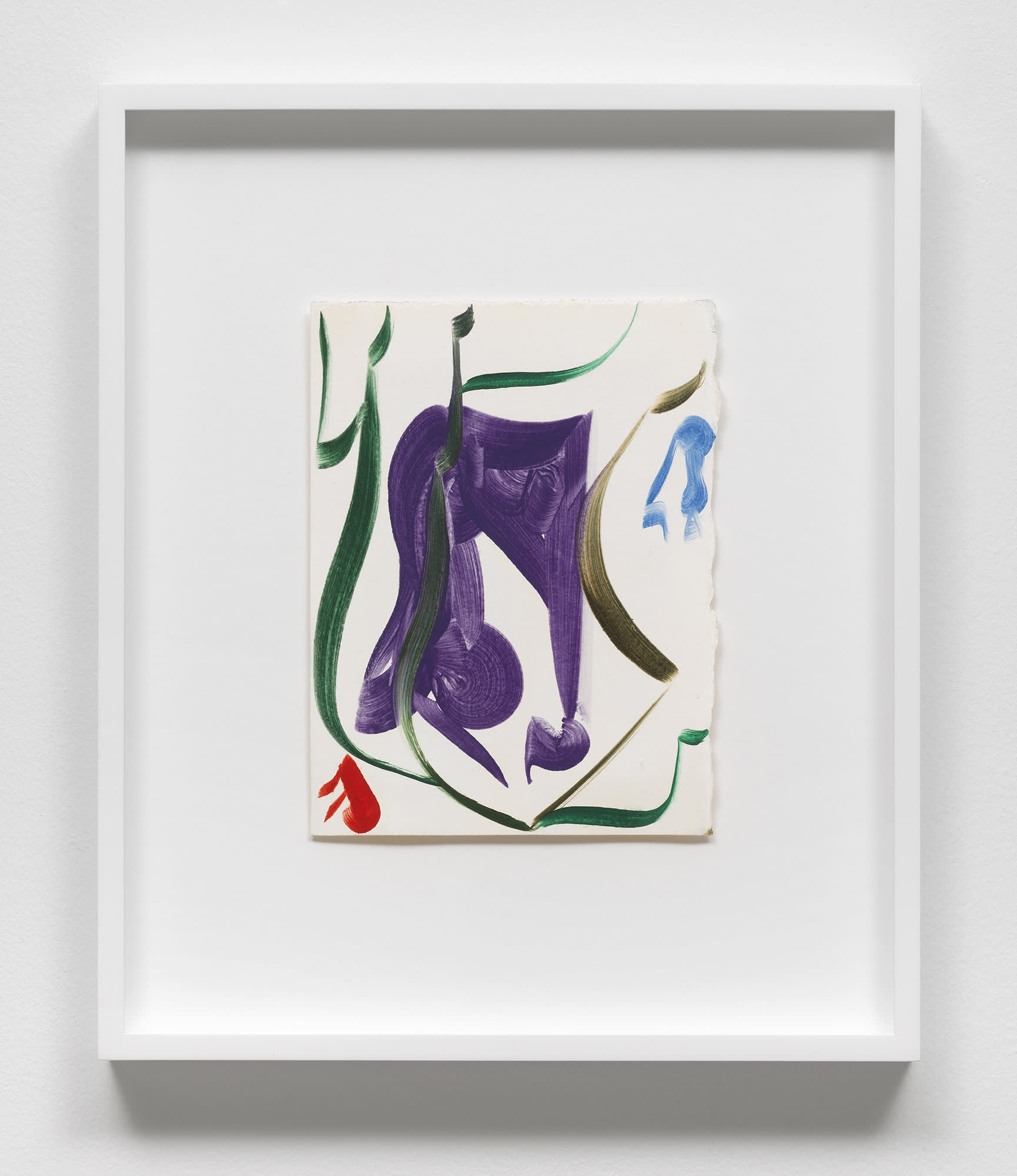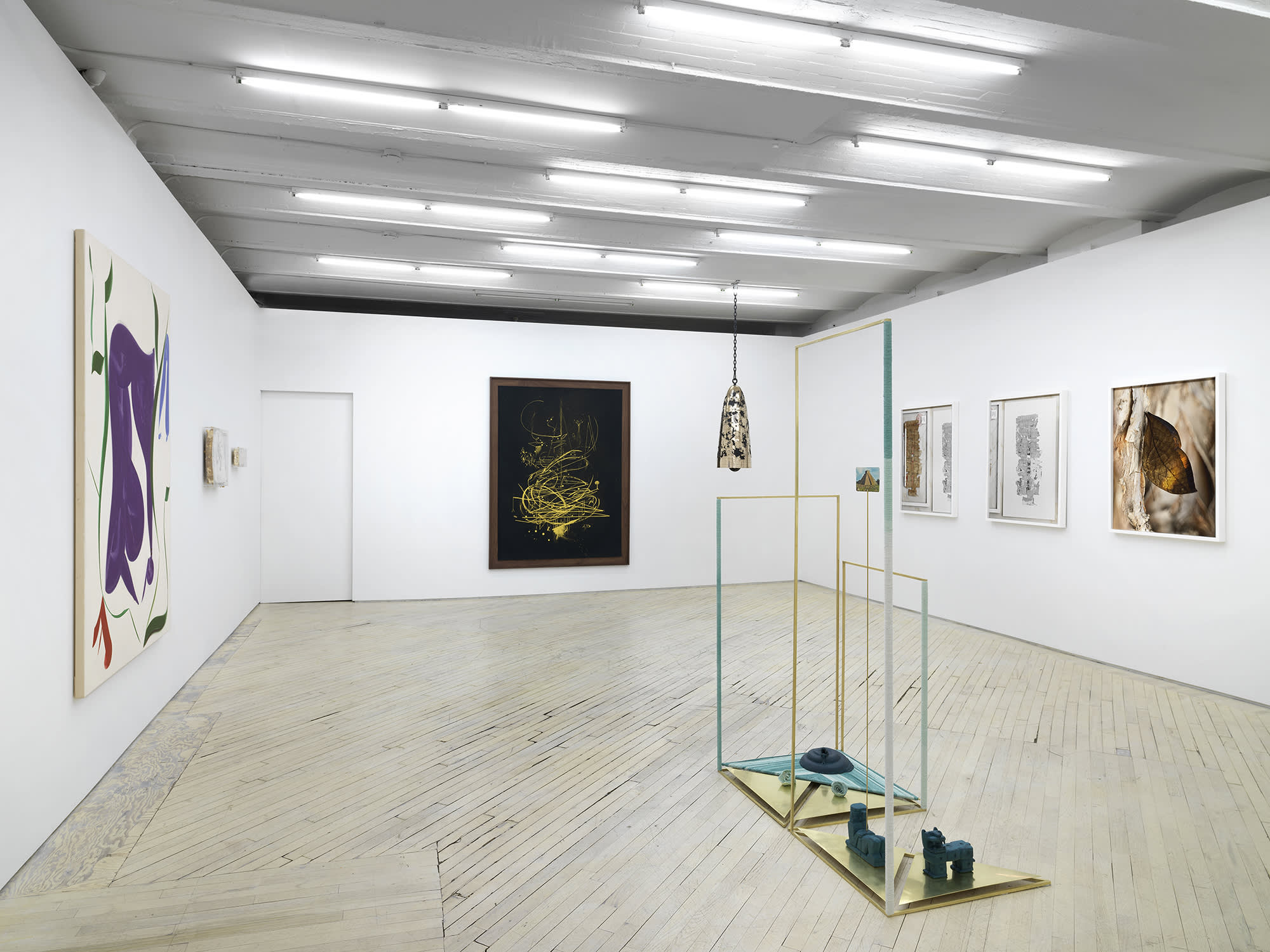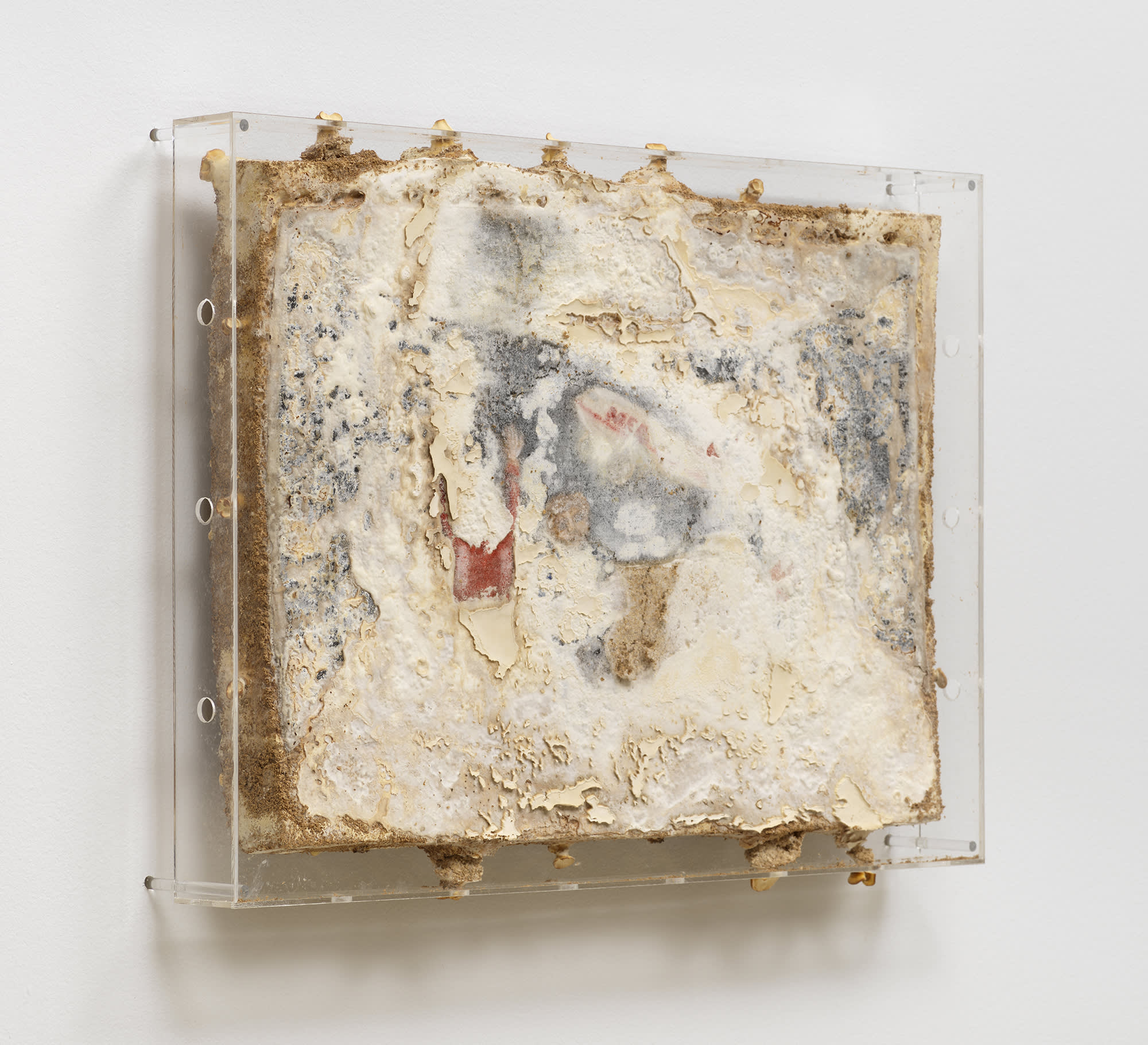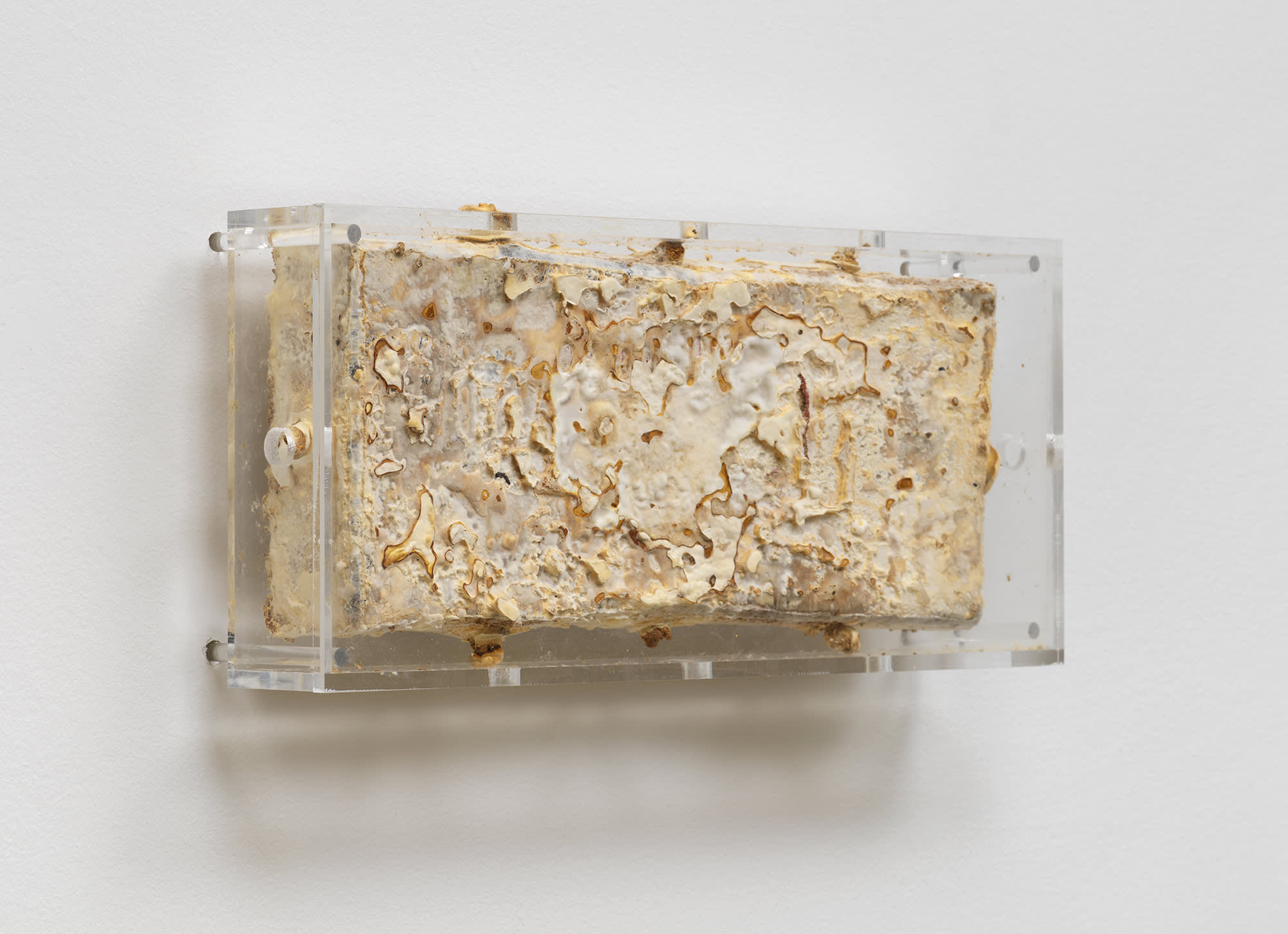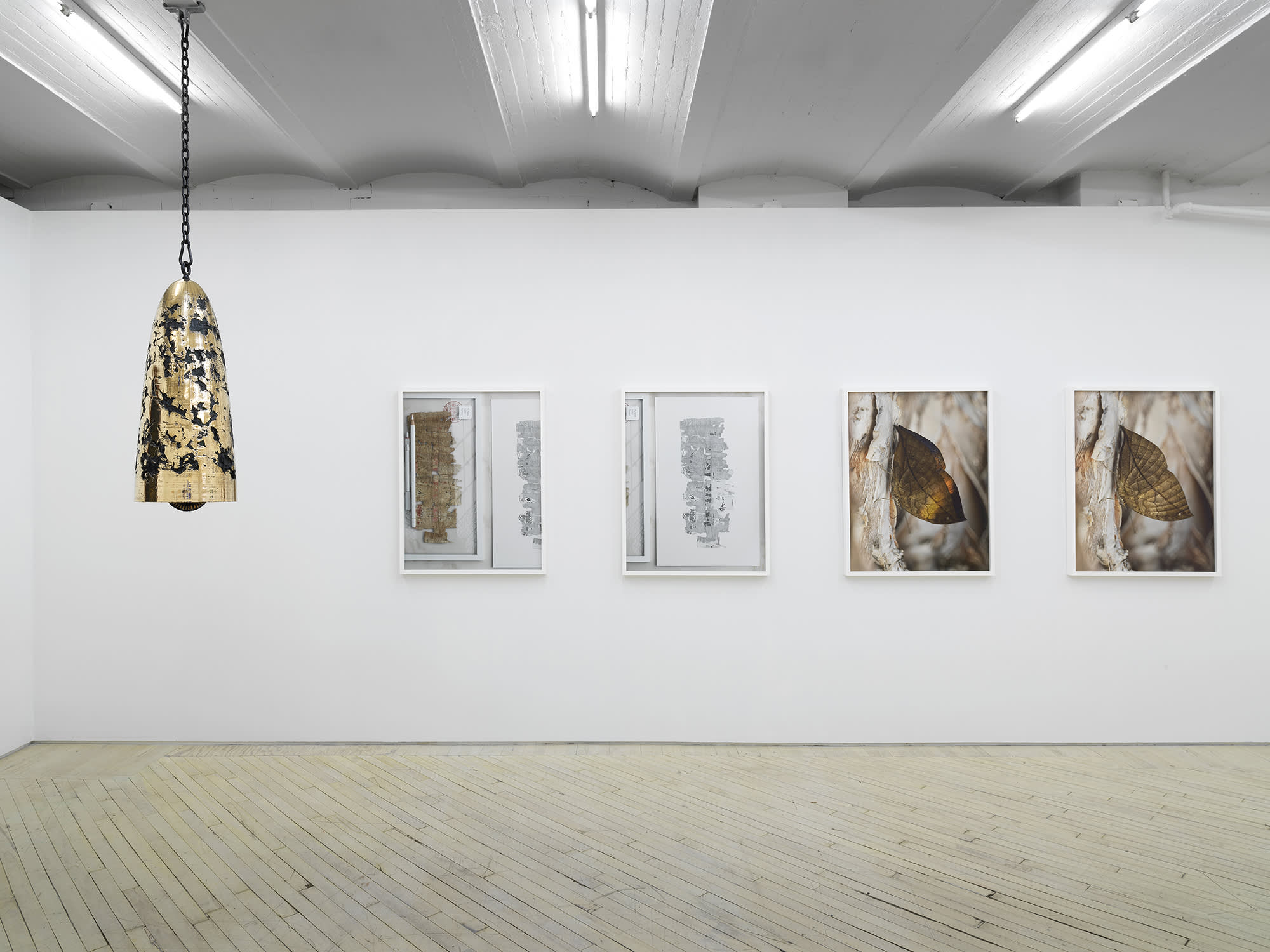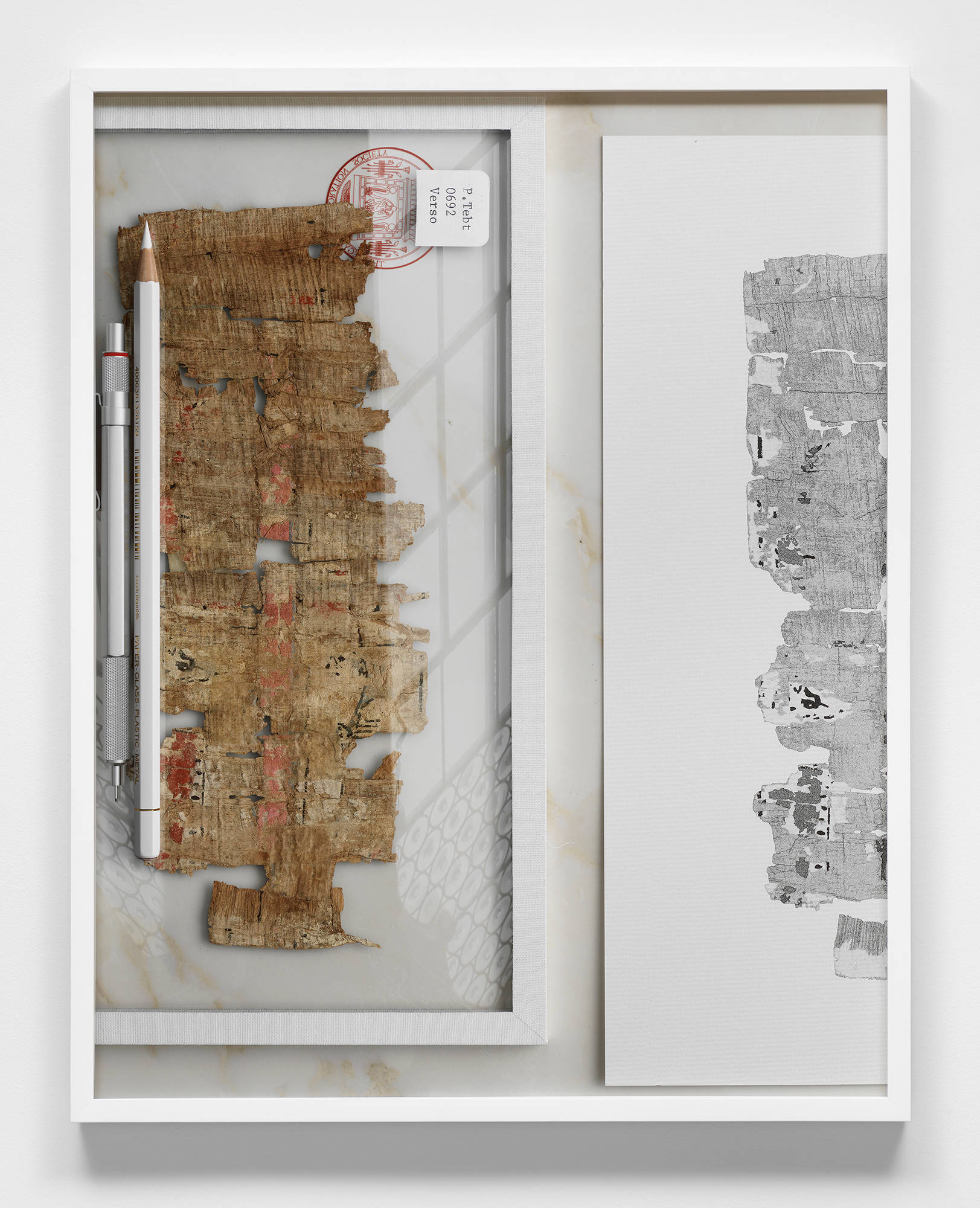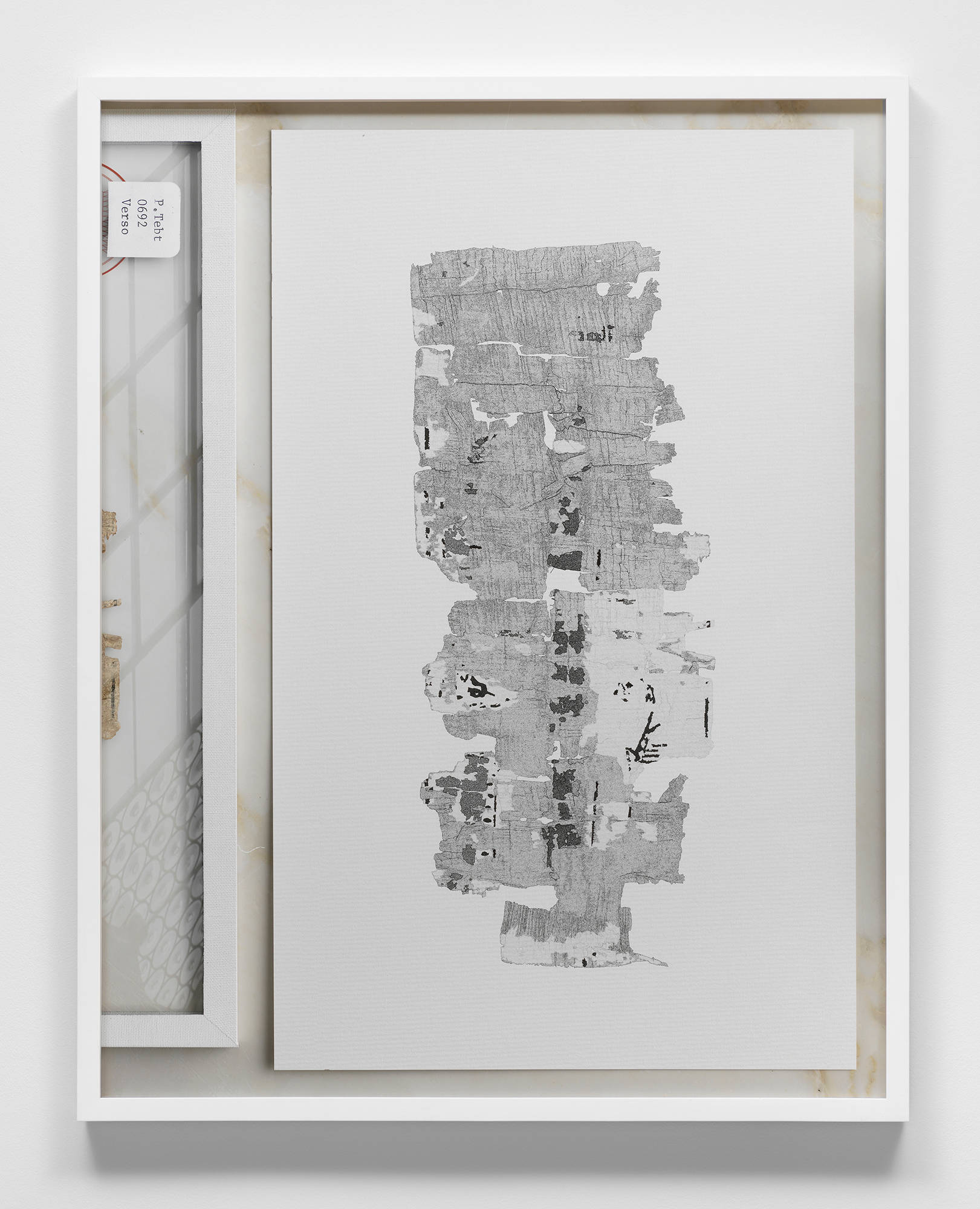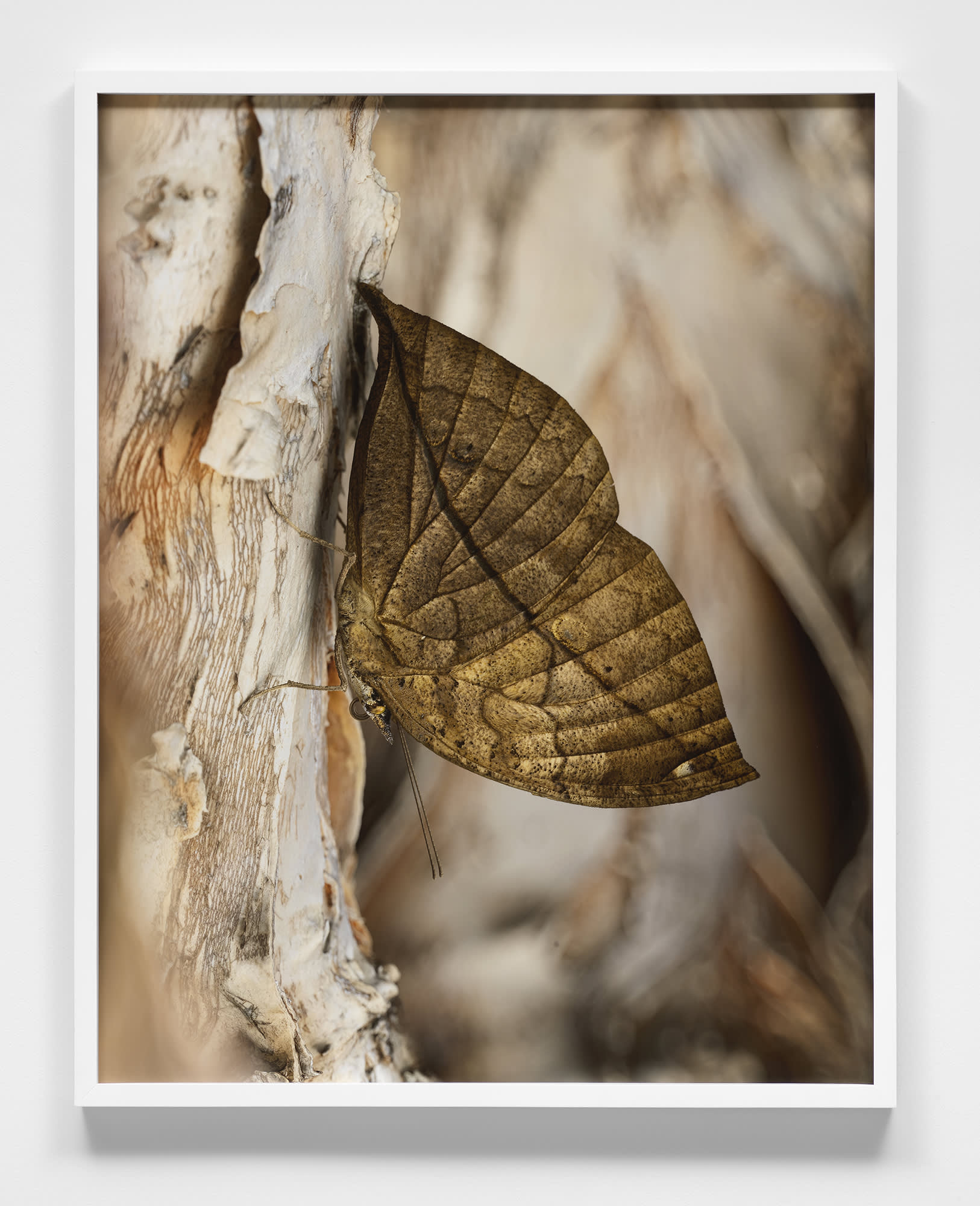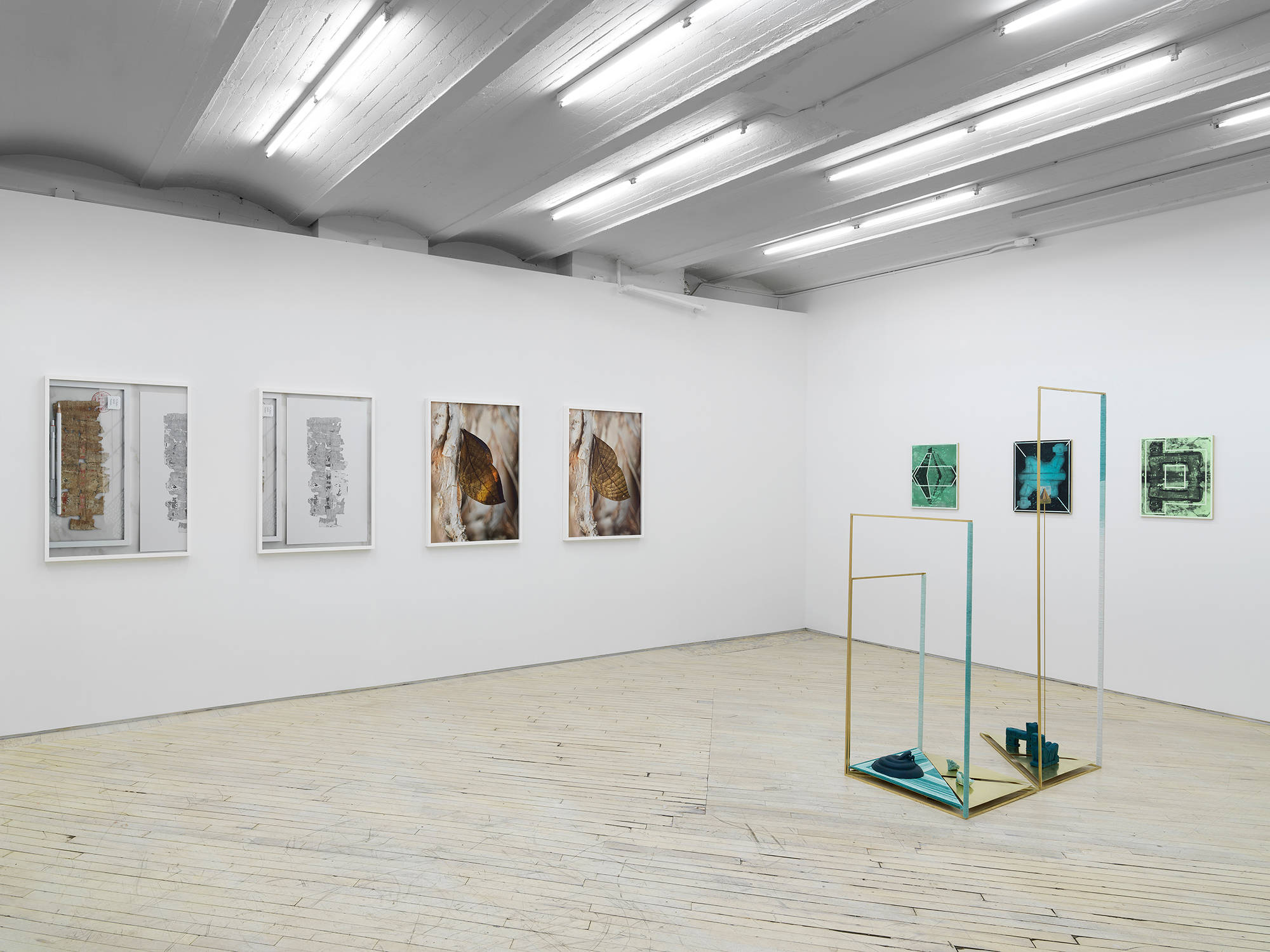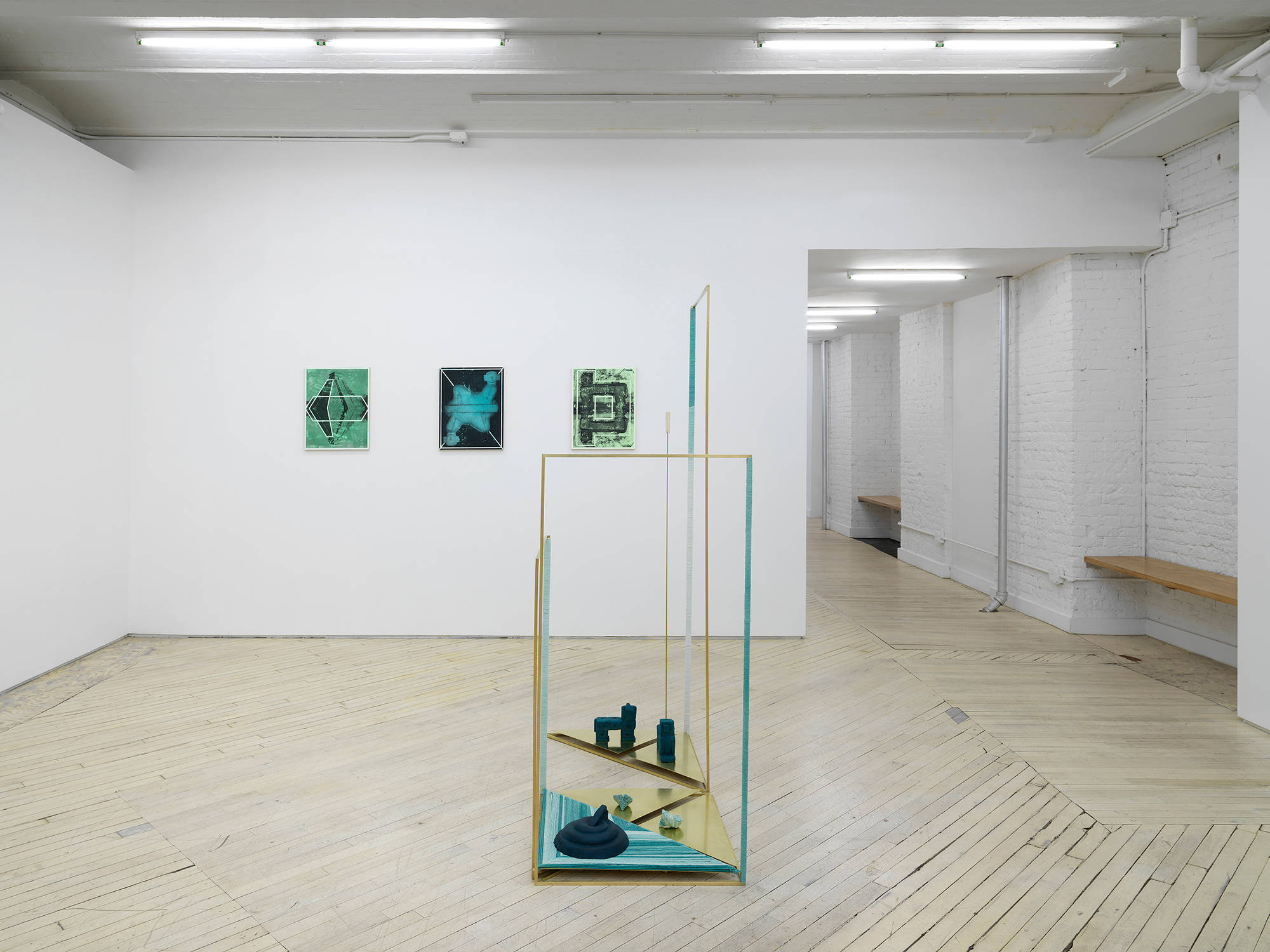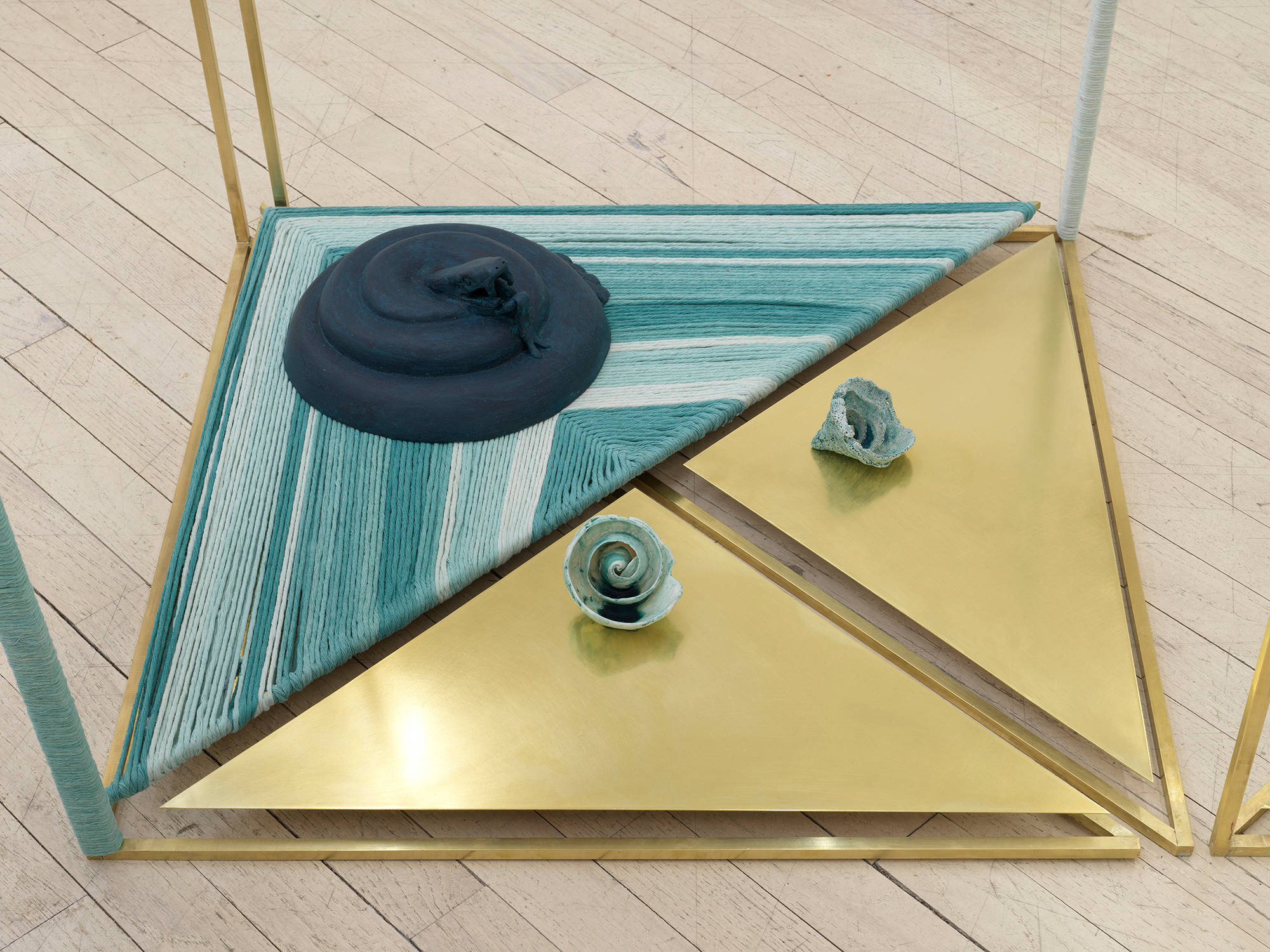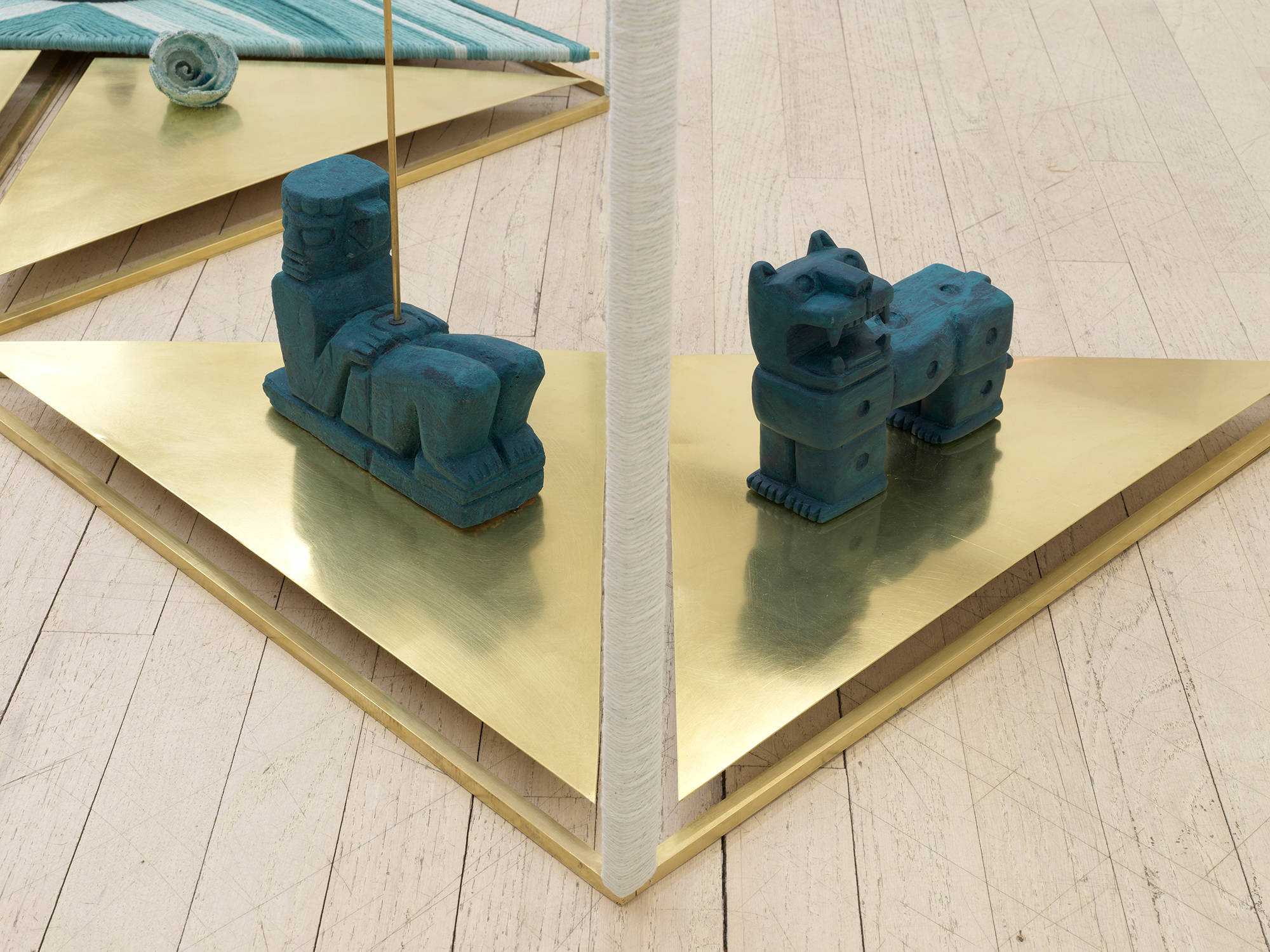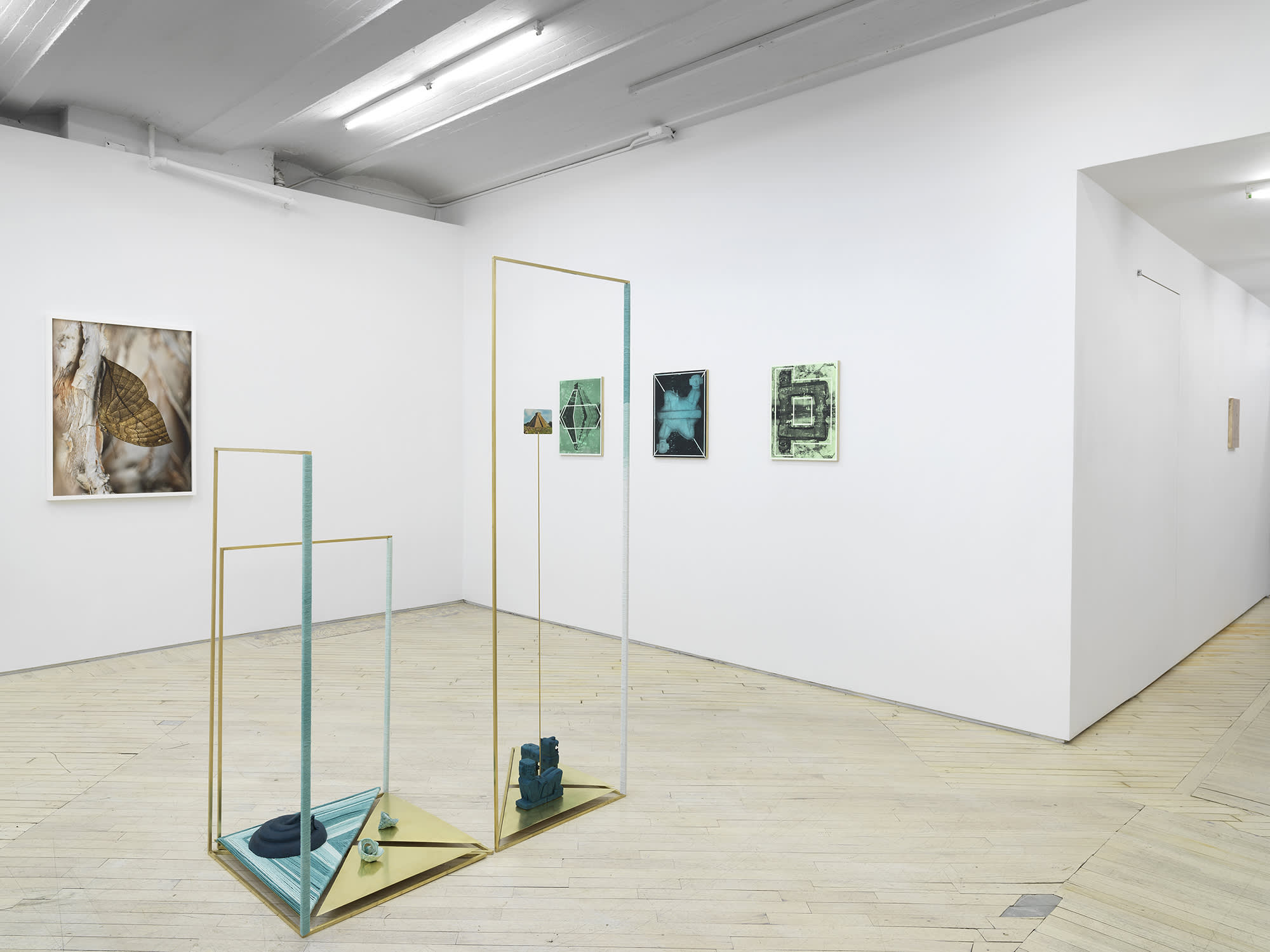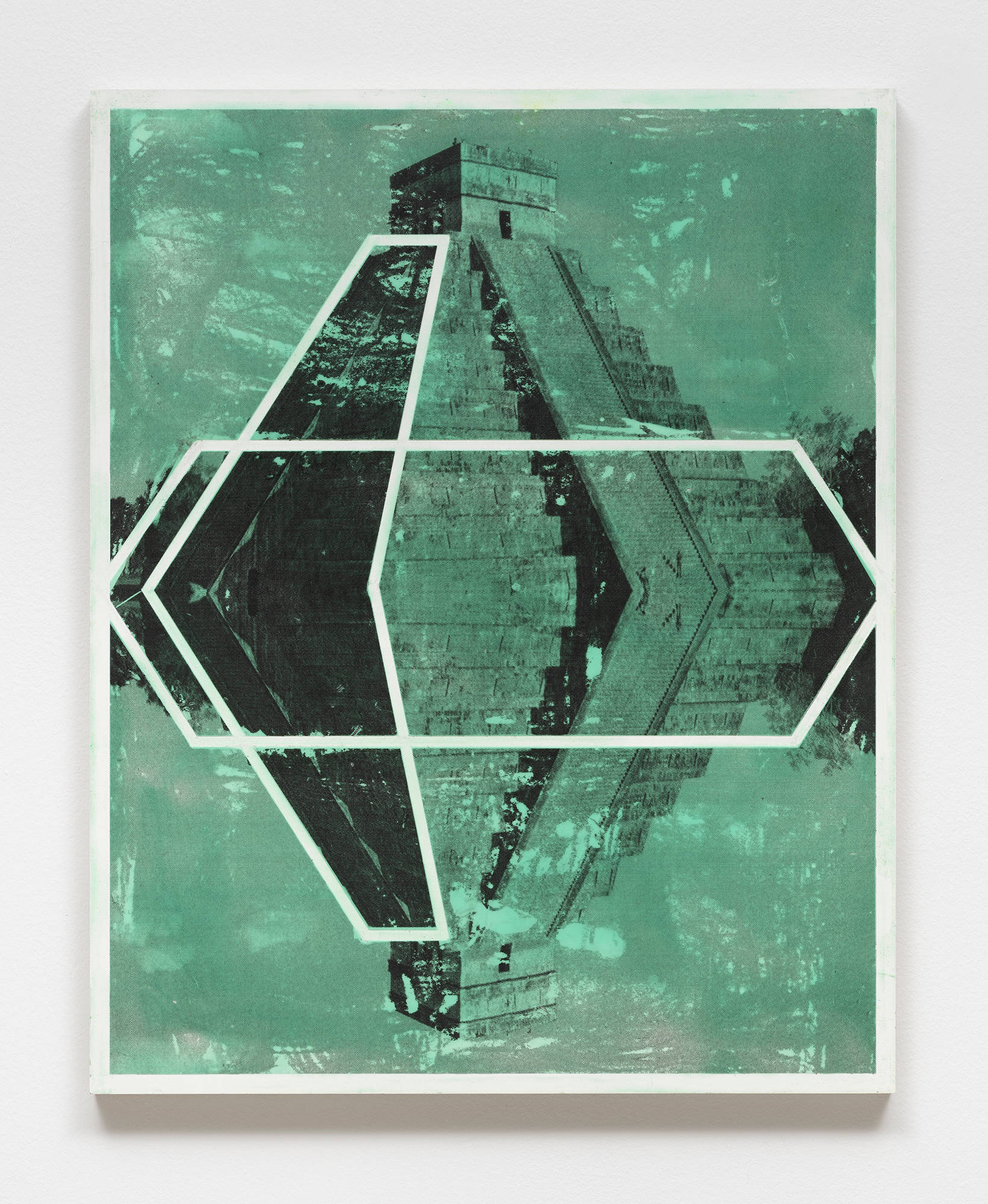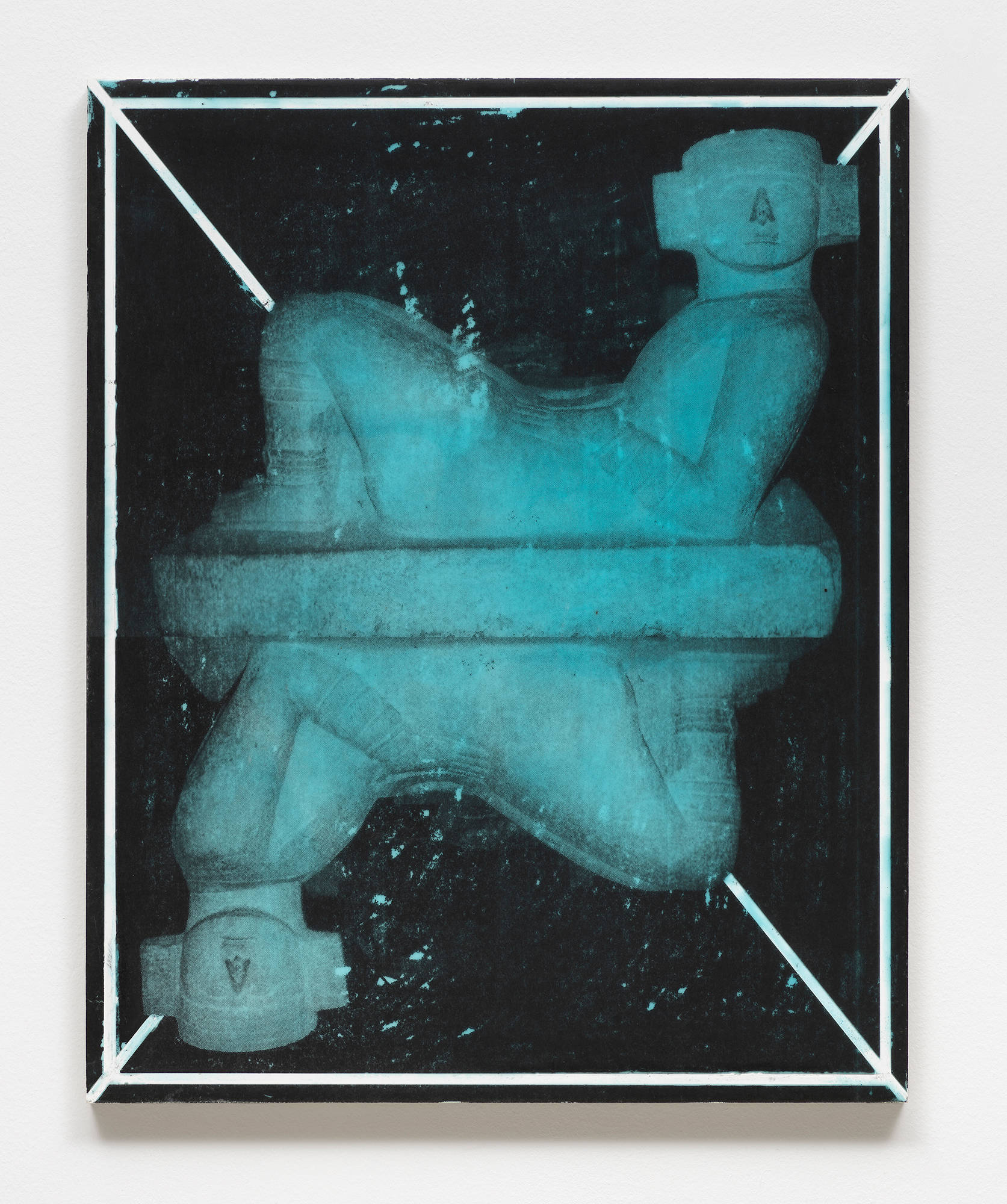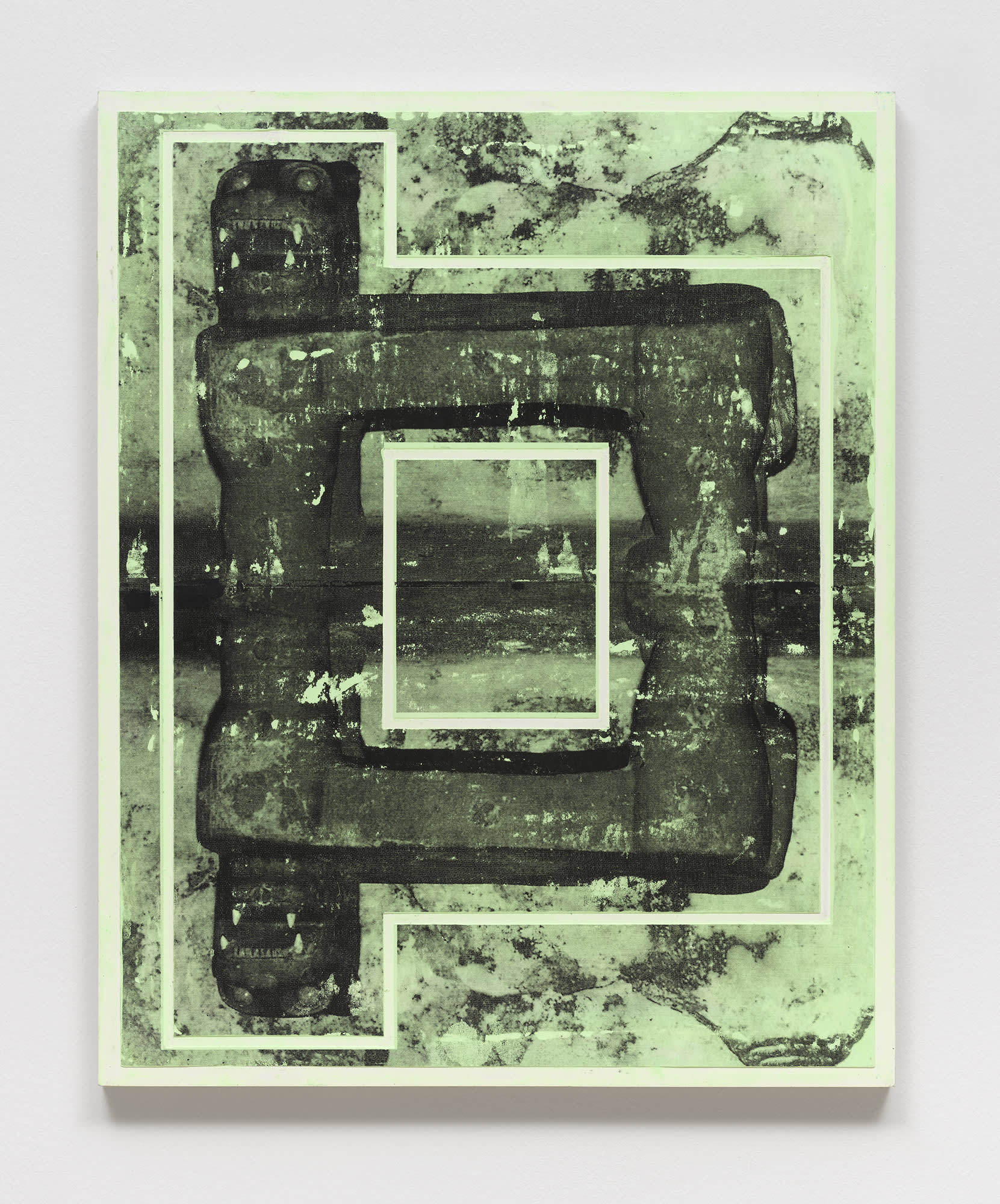Exhibition: Throughline
Throughline Nour Mobarak, Claudia Peña Salinas, Davina Semo, Jeffrey Stuker, Patricia Treib, Viola Yeşiltaç January 14 - February 25 2023
Bureau is pleased to announce a group exhibition presenting the work of six artists in various media. The image of a lone pay phone on a quiet and curving city street opens the show. Viola Yeşiltaç’s silver gelatin print, The Surveyor, captures a receiver-shaped phone cabin - an antiquated but universal symbol for the potential of communication and connection. A ring from another place - or perhaps another time - opens the line; a sound wave is the conduit into the show.
Thrumming the wires to reverberate, Yeşiltaç also presents a painting which shows buzzy lines of gold ink on the reverse of black faux-leather. The central illustration could be hovering on the surface of its substrate, or perhaps it is multi-dimensional, within an endless field of black space. The velvety surface supports an animated composition of interlocking geometric forms dotted with small symbols and notations in an almost calligraphic language, ecstatically layered and sketched onto a blackboard-like surface.
Patricia Treib’s works share this sense of gesture and movement of line, with script-like brushstrokes of oil, here presented on small works on paper and one large painting. At both scales, Treib offers a suite of works from a single original source image; each echoing with its siblings and revealing a long history of studied looking, all inscribed within Treib’s lush strokes. Nothing is fixed; every change of light modulates a color, every movement compels a change in scale and proportion. Treib plays with a mercurial subject, which could be seen as time itself, whose changing nature, as well as the observer’s own ungraspable constancy, remains illusory.
Nour Mobarak’s works support this embrace of the unstable nature of objects, presenting two works from her Mycelium Memory Paintings, which use the growth of saprophytic mycelium fungi to alter, and in essence, erase, the surface of her paintings. In an act of self-defacement, the artist lets go of the originally painted images, one a childhood memory of an encounter with a boy on the streets of 90s Beirut, another of a family gathering in an airport to cheer her father’s departure. The surface of the paintings cedes its pictorial, narrative space to one that instead demonstrates the effects of time passing. Mobarak both fossilizes and releases these image-memories, with a desire to explore the intangibility of the ever expiring past, and, in her own words, ‘give form to death and decomposition.’
Jeffrey Stuker’s work likewise investigates the illusory and unstable nature of representation. Stuker presents two pairs of images: one a study of an ancient fragment of papyrus containing lines from a lost Sophocles play, Inachus, the other depicting a butterfly, Kallima Inachus, that perfectly mimics dead oak leaves for its own protection from predators. While Stuker’s images are exactingly engrossing, these pictures are part of his most recent project which originated from an image that came to the artist in a dream. The work willingly follows lines stemming from the unconscious, or from worlds beyond our rational minds.
Claudia Peña Salinas mines stories of humanity’s ultimate dream: that of divine and mythological belief. Taking inspiration from pre-Columbian symbology and architecture, Salinas’s sculpture and painting here focus on the Mayan temple of Kukulcán (El Castillo) at Chichen Itza. For her sculptures she makes minimal frames out of thin brass dowels which she secures by wrapping with hand-dyed thread. At the base of this airy geometric structure sits statuettes of El Castillo’s related deities Chac Mool, the red Jaguar and Kukulcán, each painted with a blue pigment, sacred to the Maya. Her paintings also focus on the iconography and mathematical logic of the temple and its deities. El Castillo was designed to align with the celestial, and on the equinoxes two serpent figures of Kukulkán at the base of the pyramid appear to have their long tails running down the side of the pyramid. Grounded upon the earth and aligning with the heavens, the earthly viewer may experience and contemplate the throughlines of impermanent matter and the immaterial.
Davina Semo’s work tests the fixity of the material realm, working in cast bronze. The artist focuses on patinating and polishing the surfaces which reveal movement and flow to the otherwise permanent objects. Her wall piece Reach is a kind of shining, ornamental fossil, showing a motif of three bending flowers made by twisting, dragging, pressing and otherwise carving the composition using simple tools. The flowers might animate as the play of light dances on the surface. In all of Semo’s reflective surfaces the viewers and specific locality become part of the visual quality of the object itself. Similarly the hanging work Luster, suspended above the viewer, invites interaction both visually, and physically. The artist has focused for several years on the form of the bell, and here, Luster radiates with potential, as a vessel ready to sound and reverberate.

Viola Yeşiltaç, Die Landvermesserin (aus der Istanbul Serie), 2018, Silver gelatin print, 23 × 20 in.
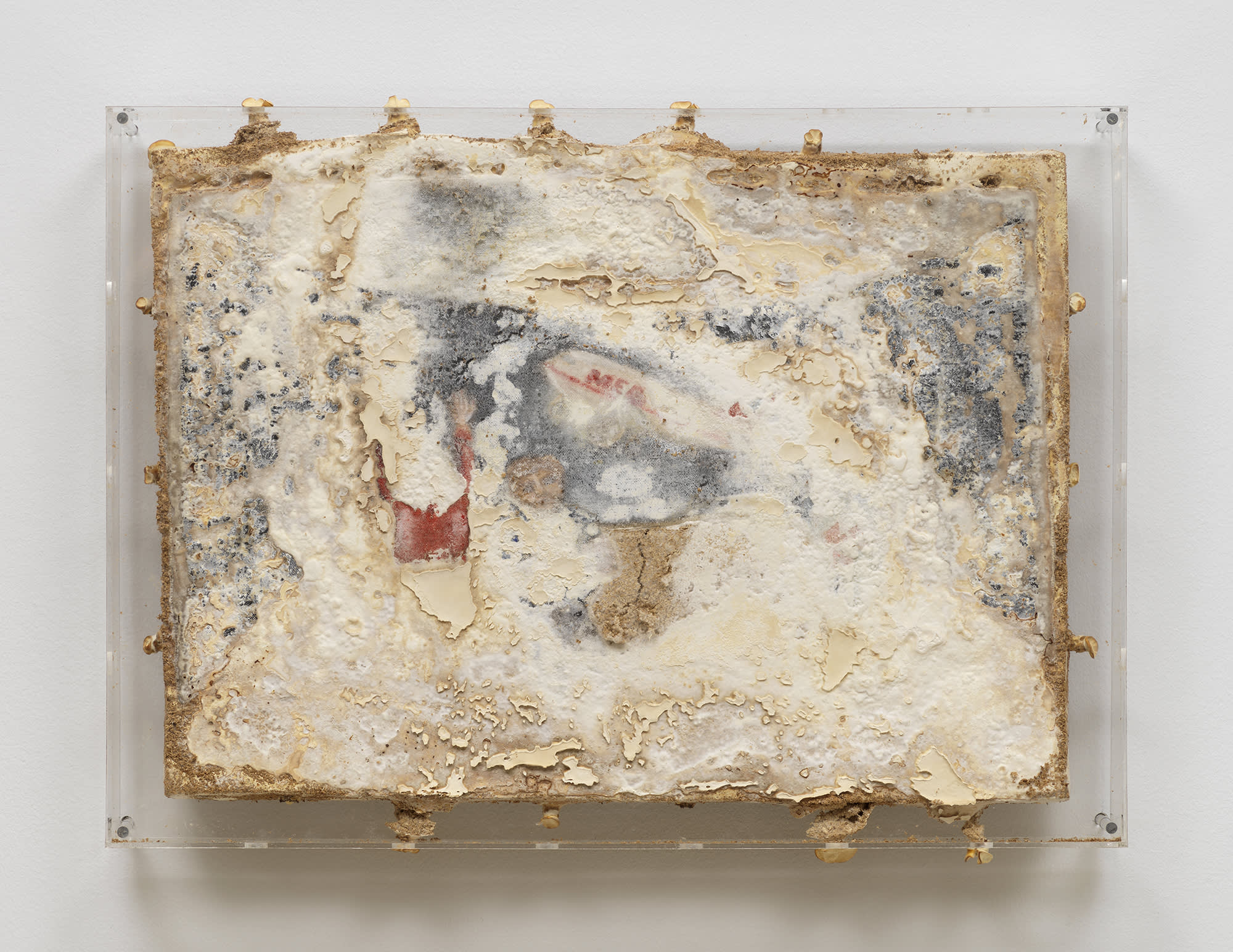
Nour Mobarak, Washington D.C.: Family and Friends Cheer as Father’s Plane Takes Off, 2021, Raw linen, oil, trametes versicolor, wood, millet, acrylic glass, 16 × 22 × 2 in.
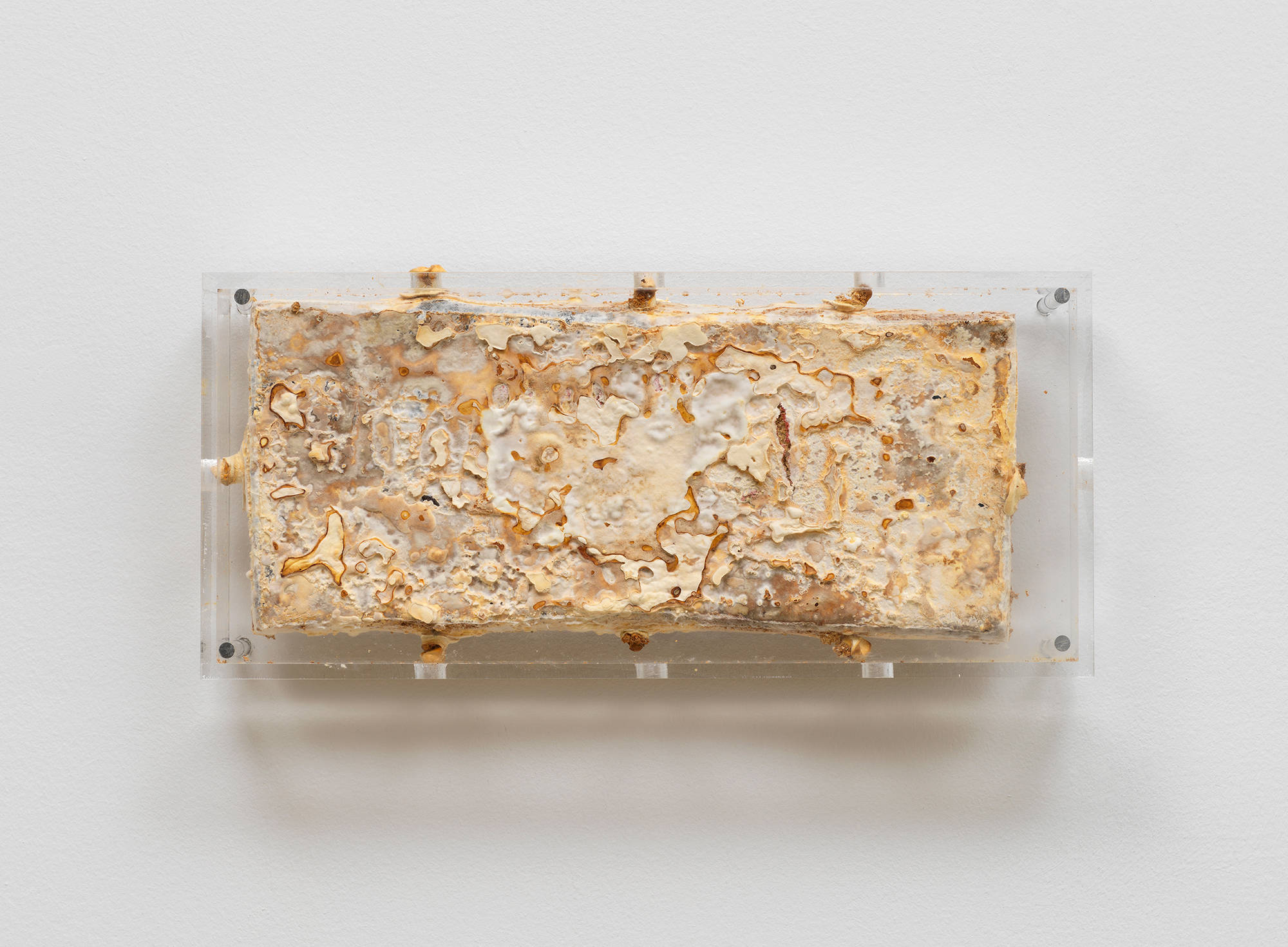
Nour Mobarak, Beirut: Child Selling Lebanese Chicklets in the 90s, 2021, Raw linen, oil, trametes versicolor, wood, millet, acrylic glass, 5 × 12 × 2 in.
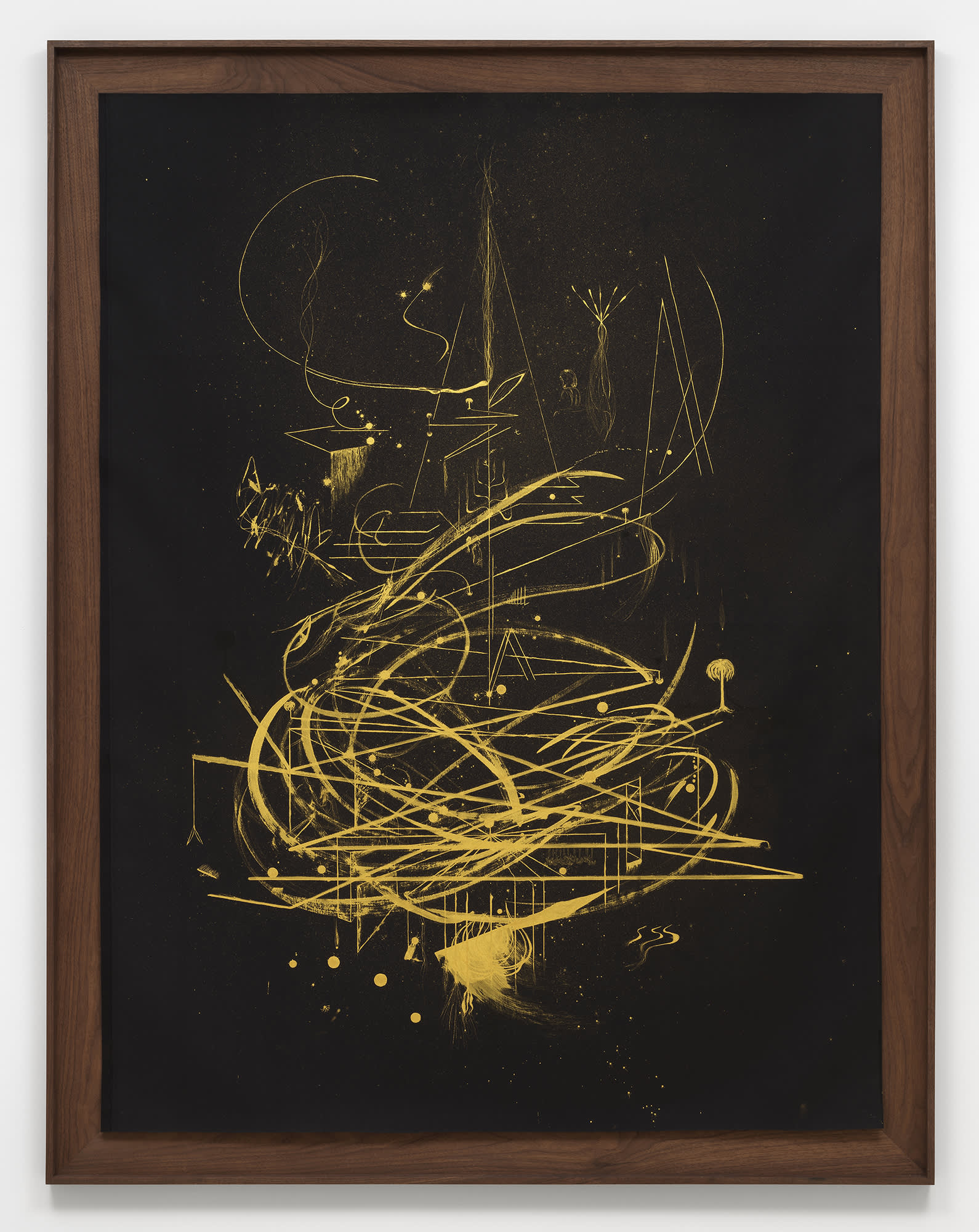
Viola Yeşiltaç, Alle Normalformen der quadratischen Gleichung, abgeleitet aus meiner Kniebeuge (aus die Landvermesserin), 2022, Calligraphy ink on the reverse of black pleather fabric, 73 × 53 ¾ in.

Davina Semo, Luster, 2022, Polished and patinated cast bronze bell, leather wrapped solid bronze clapper, hemp shibari rope, powder coated stainless steel hardware, and powder coated galvanized steel chain, 32 × 13 × 13 in.
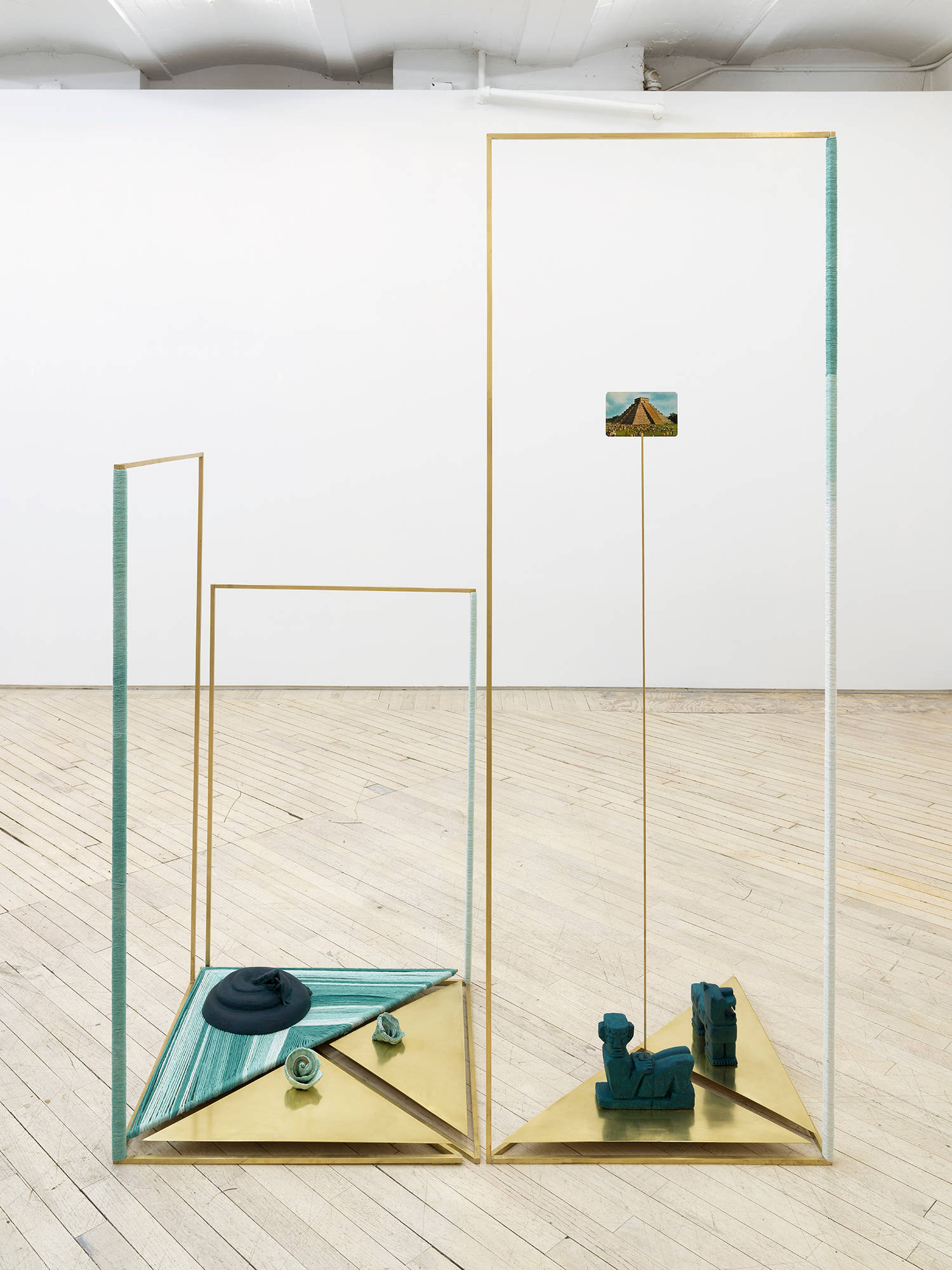
Claudia Peña Salinas, Ahua Can, 2023, Brass, dyed ceramic, wood and shell found objects and thread, postcard, 72 × 50 × 25 in.
Nour Mobarak (Lebanese-American b. 1985, Cairo, Egypt) lives and works in Los Angeles, CA, and Athens, Greece. Mobarak received a BA from the University of Sussex, Brighton, England, and did further studies at Université Paris-Sorbonne, Paris IV, France. Recent solo exhibitions include Dafne Phono, JOAN, Los Angeles, CA, 2022; Logistique Elastique, Miguel Abreu Gallery, New York, 2021; Sphere Studies and Subterranean Bounce, Hakuna Matata Sculpture Garden, Los Angeles, CA, 2020. Recent group exhibitions include Siren (some poetics), Amant Foundation, Brooklyn, NY; Symbionts: Contemporary Artists and the Biosphere, MIT List Art Center, Cambridge, MA; Looking Back / The 12th White Columns Annual, White Columns, New York, all 2022. Forthcoming solo exhibitions include Dafne, Rodeo Gallery, Athens and London, 2023.
Claudia Peña Salinas (b. 1975, Montemorelos, Mexico) lives and works between Brooklyn, NY and Mexico City, Mexico. Peña Salinas studied at the Art Institute of Chicago and obtained her MFA from Hunter College, New York. Recent solo exhibitions include Uxmal-on-Hudson, Hessel Museum of Art, Bard College, NY, 2021; Itzkan, PROXYCO Gallery/Embajada, New York, 2020; Metzilocan, ASU Art Museum, Tempe, AZ, 2019; Field Station, MSU Broad Museum, East Lansing, MI, 2018. Group exhibition include Quetzalli, DePaul Art Museum, Chicago, IL, 2021; Cosmopolis #2, Rethinking the Human, Centre Pompidou, Paris FR, 2019; Pacha, Llaqta, Wasichay: Indigenous Space, Modern Architecture, New Art, Whitney Museum of American Art, New York, 2018. Her work is in the collections of The Whitney Museum of American Art, New York; Colección CALOSA, Guanajuato; MSU Broad Museum Collection, East Lansing, MI; Es Baluard Museu d’Art Contemporani de Palma, Spain. Forthcoming solo exhibitions include Galería Pelaires, Mallorca, Spain, 2023.
Davina Semo (b. 1981, Washington, D.C.) lives and works in Los Angeles, CA. Semo received a BA from Brown University and an MFA from the University of California San Diego. Recent solo exhibitions include Reverberation, organized by The Public Art Fund, Brooklyn Bridge Park, Pier 1, Brooklyn, NY; Core Reflections, di Rosa Center for Contemporary Art, Napa, CA, both 2020. Recent group exhibitions include Drum Listens to Heart, CCA Wattis Institute for Contemporary Arts, San Francisco, CA; Strange Attractors, The Anthology of Interplanetary Folk Art, Vol. 3: Lost in Space, APALAZZOGALLERY, Brescia, Italy; Looking Back / The 12th White Columns Annual, White Columns, New York, all 2022. Semo’s work is in the collection of the National Museum of Women in the Arts, Washington, D.C. Semo will have forthcoming solo exhibitions at Broadway, New York, and Jessica Silverman Gallery, San Francisco, CA, both 2023.
Jeffrey Stuker (b. 1979, CO) lives and works in Los Angeles, CA. Stuker received a BA from Tufts University, School of the Museum of Fine Arts Boston and a MFA from Yale University, New Haven. Recent solo exhibitions include Mimicry and the Monte Carlo Predator, Garden, Los Angeles, CA, 2019; What Lies Hidden Behind the Electronic Lip, Hunter Whitfield, London, 2016. Recent group exhibitions include Mimicries, Ben Hunter Gallery, London, 2022; Objects of Desire, Los Angeles County Museum of Art, Los Angeles CA, 2022; Made in LA, The Hammer Museum and the The Huntington Garden, Museum, Library, Los Angeles, CA, 2020-21; International Biennial of Photography, Thessaloniki Museum of Photography: Thessaloniki, Greece, 2021-22. Stuker will have a solo exhibition, Plates from a Defoliated Monograph, in 2023 at Ben Hunter Gallery, London, UK.
Patricia Treib (b. 1979, Saginaw, MI) lives and works in Brooklyn, NY. Treib received a BFA from The School of the Art Institute of Chicago and an MFA from Columbia University in New York. Recent solo exhibitions include Oscillations, Galerie Nordenhake, Mexico City, 2022; Variations, F, Houston, TX, 2021; Sleeve Variations, Overduin & Co., Los Angeles, CA, 2021; Arm Measures, Bureau, New York, 2020. Recent group exhibitions include Learn but the letters forme(d) by heart, Then soon you’l gain this noble art, Adams and Ollman, Portland, OR, 2022; Weeds and Spores, Alexandre Gallery/Alexandre Fine Art Inc., New York, 2022; Field of Vision, Peter Blum Gallery, New York, 2021; Cadmio Limón; Le realtà ordinarie, Palazzo de Toschi, Bologna, IT, 2020. Treib’s work is currently on view in Friends in a Field: Conversations with Raoul De Keyser, Mu.ZEE, Ostend, Belgium. Treib was a recipient of a 2020 Guggenheim Fellowship. Her work is in the collections of Aïshti Foundation, Beirut, Lebanon; Colby College Museum of Art, Waterville, ME; RISD Museum, Providence, RI, among others.
Viola Yeşiltaç (b. 1975, Hanover, Germany) lives and works between Brooklyn, NY and Cologne, Germany. Yeşiltaç received MFAs from The Royal College of Art, London, UK, and School of Fine Arts, Braunschweig, Germany. Recent solo exhibitions include Public Art Project, commissioned by the City of Cologne, Germany, 2022; Die Landvermesserin II, Kunsthaus Rhenania, Cologne, Germany, 2020; Die Landvermesserin, Malraux’s Place, Brooklyn, NY, 2019. Recent group exhibitions include Skroderider, Billytown, Den Haag Netherlands; Archipelago, Online Archive/ Kunstverein Langenhagen, Germany, 2022; as well as group exhibitions at Modern Art Oxford, Oxford, The Kitchen, New York, and the 30th São Paulo International Biennial, Brazil. Yeşiltaç will have an upcoming solo exhibition at the Kunstverein Springhornhof, Neuenkirchen, Germany in 2023.
Photography by Dario Lasagni



